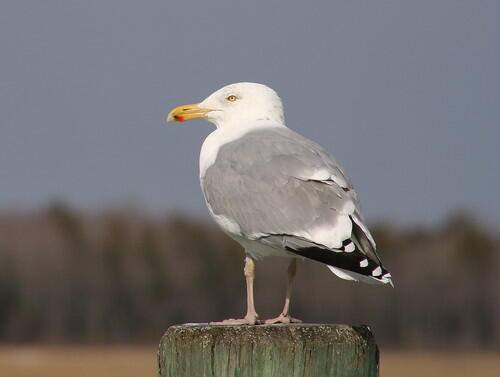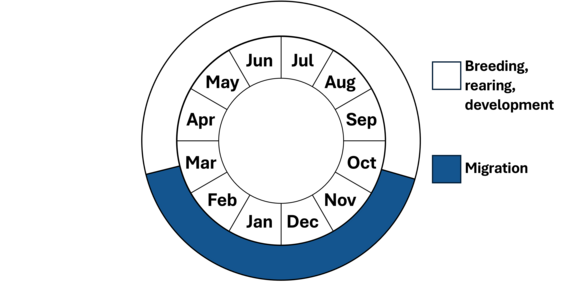- Scientific name: Larus smithsonianus
- Species of Greatest Conservation Need (MA State Wildlife Action Plan)
Description

The American herring gull is a large species of gull. They are 56-66 cm (22-26 in) long and weigh 800-1,250 g (28-44 oz). Adults are characterized by a white head and body, light gray back and wings, black wingtips with white spots (mirrors), pale pink legs, and yellow eyes. They also have a yellowish bill with a subterminal red spot. Nonbreeding adults have tan streaking on their neck. American herring gulls reach adult plumage at 4 years. American herring gulls have a “long call” which can be a series of loud calls that are made while leaning forward and lowering their head.
Life cycle and behavior

American herring gulls can often be seen in groups, soaring over the open ocean, paddling in the water, or walking along coastlines. As opportunistic foragers, they commonly spend their time bathing, preening, and resting near food sources.
During breeding season, American herring gulls will exhibit courtship rituals including mate-feeding and will both defend their breeding territory. American herring gull pairs will select their nesting site together and usually place it near water next to a rock, log, or bush to protect it from predation. Prior to egg-laying, the gulls will create up to 4 depressions and line the depressions with vegetation and other materials. The pair will choose one depression to lay 1–3 eggs in May and will incubate the eggs for 27–29 days. Young fledge by mid- to late July.
Population status
The breeding populations in New England increased throughout the first half of the 20th century, but the Massachusetts population has experienced recent declines. The Coastal Waterbird Census coordinated by the Massachusetts Division of Fisheries and Wildlife revealed that the breeding population has steadily declined over the last several decades from over 15,600 pairs in the mid-1990s to under 6,300 pairs in 2018, a pattern similar to that found for the great black-backed gull. According to the North American Breeding Bird Survey, the range-wide American herring gull population declined by 3% annually between 1966–2021, with a total decline of about 82%.
Distribution and abundance
In 2024, the herring gull was divided into four species: American herring gull, European herring gull, Mongolian gull, and vega gull. The American herring gull is a common throughout the northeastern United States. In North America it breeds along much of the Atlantic Coast, the Great Lakes, and across a good deal of the Canadian Arctic and Alaska. In the northern part of its range, the American herring gull may be impacted by displacement by the growing number of great black-backed gulls. In winter, American herring gulls are primarily found in more southerly locations including the Atlantic, Gulf, and Pacific Coasts as well as inland areas in the United States.
Habitat
American herring gulls often nest in large colonies that are located close to water and provide protection from predators (e.g., islands, abandoned piers). They are an opportunistic forager that takes advantage of both natural and anthropogenic food sources. Specific food items include a variety of fish and invertebrates as well as waste food at garbage dumps and beaches.
Healthy habitats are vital for supporting native wildlife and plants. Explore habitats and learn about conservation and restoration in Massachusetts.
Threats
Like other island nesting species, the American herring gull is vulnerable to sea level rise. Other threats include pressure from great black-backed gull populations, exposure to toxins, habitat degradation, and decline in natural food resources. Colonial nesting sites can be vulnerable to disturbance by people or predators. Collisions with offshore wind turbines pose a potential future threat to the species in Massachusetts. Plastic trash in the environment poses a threat as it can be mistaken as food by seabirds and shorebirds and ingested or cause entanglement. Ingested plastics, common for seabirds, can block digestive tracts, cause internal injuries, disrupt the endocrine system, and lead to death. Entanglement from fishing gear and other string-like plastics can cause mortality by strangulation and impairing movements.
Conservation
Protection of offshore colonial nesting sites and minimizing disturbance within the nesting colonies is important for the conservation of the species. Keeping mammalian predators (e.g., Norway rats) off islands that host nesting colonies is important for colony persistence. Avoid or recycle single-use plastics and promote and participate in beach cleanup efforts.
References
Melvin, S. 2010. Survey of Coastal Nesting Colonies of Cormorants, Gulls, Night-Herons, Egrets, and Ibises in Massachusetts, 2006-2008. Massachusetts Natural Heritage and Endangered Species Program.
Weseloh, D. V., C. E. Hebert, M. L. Mallory, A. F. Poole, J. C. Ellis, P. Pyle, and M. A. Patten (2024). American Herring Gull (Larus smithsonianus), version 1.0. In Birds of the World (B. K. Keeney and S. M. Billerman, Editors). Cornell Lab of Ornithology, Ithaca, NY, USA. https://doi.org/10.2173/bow.amhgul1.01
Walsh, J., and W.R. Petersen. 2013. Massachusetts Breeding Bird Atlas 2. Massachusetts Audubon Society and Scott & Nix, Inc.
Contact
| Date published: | May 16, 2025 |
|---|